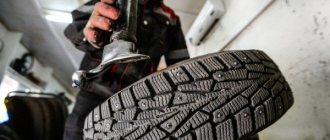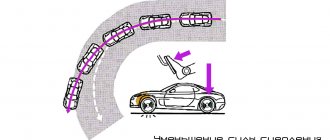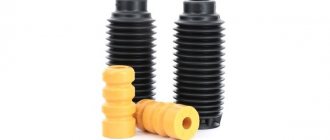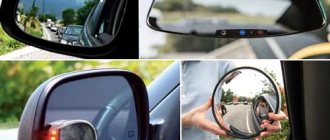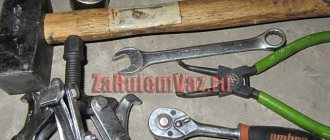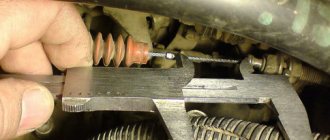The delights of front- and rear-wheel drive cars
Widespread assumptions that all-wheel drive is the ideal choice in winter are wrong . The falsity of the statement is clearly demonstrated by incorrect cornering tactics, leading to the car drifting or skidding. Important! Stabilizing the direction of movement of the machine is a problem solved by redistributing the weight of the “iron horse” forward/backward and changing the vector of the main movement (steering wheel position). A rear-wheel drive car has excessive oversteer, causing the car to skid. This kind of slipping can be prevented after careful execution of the practiced actions :
- turn the steering wheel in the direction of skidding and gradually reduce the fuel supply;
- after the obvious manifestation of oversteer ceases, turn the steering wheel in the direction of the turn and gradually increase the gas.
The front-wheel drive layout is more prone to front axle drift. The way out of a skid on such a car is outlined by other actions :
- press the gas, increasing the traction of the rear wheels by mass transfer;
- turn the wheels in the direction of the turn.
However, at low speeds (up to 40-50 km/h), the following solution is relevant for front-wheel drive vehicles: briefly turn the steering wheel towards the skid, reducing the fuel supply, then return it towards the direction of travel and pull the car with gas.
The fight against front axle drift, when the car tends to the outer part of the turn , is carried out by other means. The driver of a car with front-wheel drive must:
- carefully turn the steering wheel to a larger angle (low speed);
- smoothly reduce the gas or slow down and turn the steering wheel to a smaller angle (high speed).
The task of completely stopping skidding on rear-wheel drive has the following goals:
- at high speed, it is necessary to turn the wheels in the direction of the turn and sharply release the gas, redistributing the mass to the front axle to restore traction and causing the rear wheels to spin into a controlled skid;
- at low speed, turning the steering wheel in the direction of travel, you should briefly hold the handbrake or apply gas, causing slipping at the rear.
For your information. Controlled skidding on rear-wheel drive cars is achieved by smooth operation of the accelerator: more “gas” - the car turns around its axis, less “gas” - the car levels out.
Rear drive
There is an opinion that if a car skids, it is necessary to turn the steering wheel in its direction. An important point in this case is to briefly turn the steering wheel, after which you need to smoothly level the car. In an extreme situation, inexperienced drivers often turn the steering wheel all the way, which leads to further skidding.
It is very important to understand in advance what will happen to the car on a slippery road. It is better to move on ice with one hand, and it is important to feel the behavior of the vehicle and feel the trajectory of the wheels, which is quite difficult for those who do not have decent driving experience. If the car rotates on ice, you should turn the steering wheel in the opposite direction while returning the car to its original position.
In a situation where a rear-wheel drive car is sliding on ice, you need to release the gas at lightning speed.
The options considered apply more to domestic cars, since modern German or Japanese cars have an electronic control system. For example, BMW
with rear-wheel drive it is not so easy to skid, even on purpose, since the electronics will resist the maneuver.
When driving a rear-wheel drive car with an automatic transmission on a slippery road in winter, you can prevent skidding by performing sharp manipulations with the gas pedal. The transmission features in this case do not allow the wheels to suddenly lock. But, it is worth considering that this option is appropriate when driving at low speed, otherwise a sharp downshift can lead to gearbox failure, and this can lead to wheel locking and a skid of an almost uncontrollable car.
Features of all-wheel drive vehicles
All-wheel drive: traction distribution schemes on all wheels
The all-wheel drive vehicle flaunts clever features that attract the attention of consumers:
- has the most efficient acceleration dynamics;
- tends to overcome difficult off-road areas;
- able to easily climb ice slides.
However, not every all-wheel drive transmission is capable of efficiently implementing these characteristics. However, even the full implementation of immediate tasks does not occur in an uncompromising manner. Much depends on the layout of the all-wheel drive :
- constant;
- connected by means of automation;
- manually connected.
Permanent all-wheel drive in winter: features and difficulties
The full all-wheel drive layout ensures that power is constantly circulated between the engine and the front and rear axles. The main structural unit of the system is a transfer case , which distributes traction between two cross-axle differentials. The node includes :
- center differential;
- a locking device that provides a rigid connection between the front and rear axles (viscous coupling, friction clutch, self-locking differential);
- a chain transmission through which torque is supplied to the front axle shaft.
It is the full-fledged all-wheel drive that is an indispensable assistant in winter : power is supplied to all 4 wheels continuously both on asphalt and off-road, and the instantly activated lock allows you to confidently storm the snow-covered “intersection”.
The classic emphasis on the cross-country ability of a permanent all-wheel drive vehicle is made to the detriment of other qualities:
- large mass;
- obviously increased fuel consumption;
- the complexity of the design implementation, significantly increasing the cost of the option.
Universal technological solution: plug-in all-wheel drive
A hybrid alternative to a permanent 4x4 distribution scheme - front-wheel drive with an electronically connected rear axle on demand . The transmission layout is a complicated version of the “front-wheel drive”:
- The front axle differential is traditionally connected to the gearbox;
- primitive transfer case: bevel gear that transmits torque from the front axle to the cardan drive;
- unit connecting the rear axle: viscous coupling or friction unit.
The electronic continuously variable power distribution is tempting:
- relatively low cost of the product;
- small dimensions and weight of components;
- a slight increase in fuel consumption compared to the front-wheel drive version.
However, the solution is quite a compromise:
- on off-road and snowy areas, a blocked clutch is prone to rapid overheating and failure;
- on a normal highway, the car is practically in front-wheel drive mode (a small amount of power is transferred to the rear axle - up to 10-20%);
- full use of the rear axle is only possible when the front wheels slip or start.
It is worth noting that it is very difficult to prevent skidding with all-wheel drive of this arrangement . A sudden transmission of torque to the rear wheels, which occurs when the front axle slips, will require precious actions from the driver.
Conservative approach: manual all-wheel drive
By eliminating the differential from the full-fledged all-wheel drive system and replacing the electronic locking with the possibility of manual connection through the “transfer case” of the front axle, you can get a primitive small-sized mechanical all-wheel drive system. The design inherent to purely off-road vehicles has the following features :
- resistance to large mechanical loads;
- in the activated state, a 50/50 ratio is ensured;
- when turned on, reliable mechanics can ruin the transmission on the asphalt;
- switching occurs with the vehicle stationary.
All-wheel drive when driving in winter
Since there are two main types of 4x4 axle versions, the features of each should be considered.
Drive with additionally activated front axle. Manufacturers recommend using the front axle when driving slowly on muddy roads. Certain owners of such cars ignore these tips, believing that with the front axle connected they can drive quickly in the snow. But, since these models do not have a free center differential, the maneuverability of the vehicle is significantly limited. This is fraught with the risk of going into a ditch due to both bridges sliding along the winter road.
Crossovers equipped with Haldex
, have a good system for adjusting the drive elements. However, wheel slipping can cause overheating of the internal fluid and subsequent division of the load along the axles. In icy conditions and in the middle of a turn, this threatens the driver with an emergency situation.
Experts advise checking the car in an empty, deserted area, accelerating it, letting it skid and observing the behavior of the vehicle. This technique will help you feel the characteristics of the car when various unforeseen situations arise.
Permanent all-wheel drive. The best option for driving on winter roads. But, it must be remembered that driving at high speed on ice can lead to sudden uncontrolled side sliding. There is no actual skidding, but the car is carried away from the track with the body remaining unchanged. You can stabilize the car by gradually adding gas. For this maneuver, you need to take into account the width of the road, since the car will not “come to its senses” immediately.
Also, all-wheel drive SUVs, when actively pressing the gas pedal and sharply turning the steering wheel, tend to drift off the front axle. When you try to level the vehicle in the usual way, sudden adhesion of the aprons of the wheels to the surface may occur, which can lead to skidding.
4x4 driving
Control Features
Arguing the superiority of the 4x4 system over single-wheel drive configurations in winter conditions, inexperienced motorists rarely take into account the peculiarities of its behavior on slippery areas.
The dominance of four-channel traction is:
- neutral understeer, allowing you to corner at high speeds with maximum effort and attention;
- minimum time (compared to single-wheel drive cars) to perform the only correct action in emergency situations (demolition/skidding);
- a relatively late onset of the gliding phase, requiring maximum concentration and appropriate training of the pilot.
When negotiating a turn in winter in a car with all-wheel drive, it is easy to notice the following features :
- during the passage of the “entry point - apex” section, the behavior of the car is identical to a car with rear traction;
- At the exit of a turn, understeer, characteristic of all-wheel drive vehicles, appears.
Sudden skidding of a four-wheel drive vehicle: what to do?
Preventing a sudden slip of a single-wheel drive car is possible even for an inexperienced driver - he knows for sure that he must press the gas on the front traction and release it on the rear.
Important! The main tool in the sliding process of a front-wheel drive vehicle is traction. If slipping occurs during a turn, it is strictly prohibited to release the gas!!!
The classic behavior of a “all-wheel drive” when sliding is as follows:
- a sharp release of the accelerator - the demolition of all four wheels with the subsequent turn of the front part towards the exit from the bend;
- smooth release of traction - the car goes in the direction of the turn;
- increase in traction - the trajectory of movement straightens.
It is not worth strictly adhering to the theoretical behavior of the 4x4 system. The vehicle's weight distribution, individual design and distinctive settings of the differentials and locking electronics can lead to completely different reactions. Therefore, motorsport experts strongly recommend assessing the car’s behavior in a closed area.
The key to maintaining control over the car when sliding is synchronized operation of the gas and slight swaying of the steering wheel. This is the judgment that rally pilots and other motorsport masters are guided by.
Elementary alignment of the car at the entrance to the turn often helps to avoid a critical skid in a slippery turn on all-wheel drive:
- the position of the gas pedal does not change (remains pressed);
- slow down slightly with your left foot;
- turn the steering wheel to a minimum angle towards the turn (never turn towards the skid).
You should not abuse the steering angle:
- wheels too turned out + good loading of the front axle (good grip) lead to skidding;
- a large steering wheel angle and poor traction of the front wheels lead to drift.
For your information:
- cars with automatically engaged all-wheel drive are very dangerous when sliding: the transmission can switch to all-wheel drive when the front wheels slip and vice versa;
- at the border of balance, the limited slip differential is prone to braking the wheels, causing skidding;
- modern electronics are often designed for incorrect actions by beginners: for example, when skidding in a front-wheel drive car, not only releasing the gas, but also braking is allowed.
How to drive in winter with rear-wheel drive or all-wheel drive? Driving safety
Many novice car enthusiasts are wondering how to drive rear-wheel drive or all-wheel drive in winter in order to protect themselves and passengers from troubles and emergency situations.
Considering that domestic winters quite often delight drivers with snow and ice, and the quality of roads leaves much to be desired, regardless of the type of vehicle drive, you should be careful and be extremely attentive. However, transport has its own peculiarities. Driving experience and practical skills play a significant role in proper control of a car in winter. Naturally, theoretical knowledge of the nuances is also necessary.
How to drive in winter with rear-wheel drive or all-wheel drive? To understand this, you should consider the characteristics of driving in extreme situations, as well as the behavior of the car on the road.
Rules for driving on permanent all-wheel drive.
I’ll say right away that I’m sorry.
I’ve had about 10 years of experience already, I’ve always had front-wheel drive cars, and I got fed up with the fact that they don’t clean the city, and in winter it’s simply impossible to drive around the city, I decided to buy a jeep or SUV, the choice fell on a Toyota RAV4 1997. with 4WD. Well, I rode it in the summer, I was very happy with the fact that you can climb almost everywhere on it, and it’s just right for a family and a summer house. Cool car.
And then winter came. Well, I prepared the car (fluids, battery, and suspension) for winter, of course, and also changed the tires to winter ones, although not studded ones on Michelin Alpine 4x4 (215/70/R16). In our city, the first snow and ice, as always, like a natural disaster, utility services did not expect snow and did not know it, in the evening there was heavy rain, then it started snowing, in the morning there was already 10-15 cm of snow, and at the same time, already frozen, and there was ice below. I needed to go to the dacha with my mother-in-law in the morning, so I tore the car off the snow, started it, drove off, well, the roads, as always, were not cleared, there were ice blocks at the turns, and on the road there was an ice slide with a ridge. We are not us, we are in a jeep, I am happy that the car drives so well through the snowdrifts, and goes through the snowy mess, well, a great car, super. We left the city, well, as always, out of habit with front-wheel drive, I’m flying at 70 km/h, and I don’t see that on the road outside the city there is a strong wind and ice and crust. Well, okay, I’m flying, and at some point during the detour, I don’t remember what, the car starts to spin (or drifting), out of habit, I have front-wheel drive, I press the gas pedal, I think, somehow I can get out of this drifting, but nothing happens , in front of me, in the left lane, there are cars and a traffic lane, well, I think, as long as I don’t fit in, what the hell, I’ll fly off the road, there are snowdrifts, I’ll brake on them. In these thoughts, I turn the steering wheel in different directions, try to stabilize the movement of the car, and get out of drifting, I move away from the cars, then I see that I am being carried towards the regular groove, the driver, he also sees that I am being carried sideways towards him, We are leaving each other, thank God, we left, while I was being carried towards him, it dawned on me that I needed to slow down with the engine, i.e. You cannot press the gas pedal in this situation. This all happened in just 1-2 seconds. My mother-in-law was sitting next to me and didn’t say anything, I said to myself, screw it, I got some adrenaline, I’ll drive back more carefully, I’ll have enough of this drifting with the first snow. One thing that upset me was that I didn’t notice the number of the regular slot so I could drive up to apologize to him and give him a bottle as a sign of gratitude.



